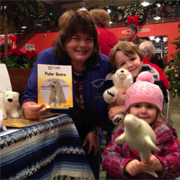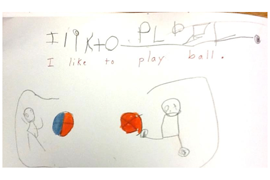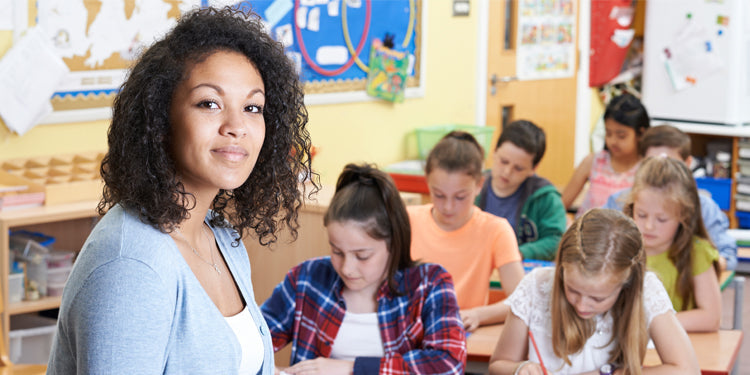
Developmental Writing Stage: Consonants Represent Words (5–6 years old)
Children in the “Consonants Represent Words” stage of writing are learning that letters of the alphabet can be arranged in different order to make a unit called a word . They have mastered alphabet recognition and the sounds of each letter. The child is learning to leave spaces between word units on a page. Words are combined to create a message.
Phonetic inventive spelling will be present because they spell exactly what they hear (e.g., luv/love, haws/house, wachid/watched). Vowel sounds may be left out of the words (e.g., blt/built). Knowledge of silent letters is not evident in the writing (e.g. pla/play, lik/like). The child is building a bank of words from letter sounds and sight words that are often used and quickly recognized (e.g., the/and/at/to). Sentence formation is beginning to appear as they leave space on the page between words. Left to right movement across a page is evident.

|

|
| I like to play ball. | One day one pig built his house out of bricks. |
|
|
|
| Look at the rain. It is falling on a pig. | Meli did bark when she watched TV. |
* Create words with magnetic letters. A metal cookie sheet or pizza pan are easy portable surfaces to use with magnetic letters. Select letters that are accurate representations of the letters. Say the word and listen for the letter sounds (phonemes) in the word. Select the letters that are needed and create the word. As they say each sound, push the letter with an index finger. When they are finished sounding out the word, pronounce the entire word. For an extension, try mixing up the letters of the word and ask the child to unscramble the word.
* Encourage the children to illustrate their text. This helps them to connect meaning to the printed words and show what they are thinking.
* Writing down the message as they dictate allows children to see the words modeled correctly. Ask them to tell you about their sentence and illustration.
* At this stage of writing, it is best to use unlined paper . Spatial awareness is still developing and controlled writing on a line is not yet recommended.
* As the child reads his or her own writing, ask the child to listen and count how many words are in the sentence. Read the sentence again. Ask the child to count how many words are in the sentence by touching the words.
* You may begin to introduce the idea that a period will come at the end of a sentence or complete thought. Talk with them about the idea of the period acting like a stop sign to signal the end of a thought.
* Talk about how stories are made up of more than one sentence. Help them to construct a short story using one page of paper for each sentence and illustration. Ask them to read their story to two or three people.
* Collect their own stories and put them in a special shoebox or basket . Let them decorate the container. Select one or two of their stories for them to practice reading at bedtime.
* Encourage and praise their writing efforts.
In the Garden is a story in Set C of the Kaleidoscope Collection. It is written on Level D and contains repeated phrases and predictable text. “I can see a worm. It is in the dirt. I can see a bee. It is on a flower. I can see a ladybug. It is on a leaf.” This style of writing is encouraging to beginning writers/readers because they can readily recognize the predictable sight words. Most children will be able to relate to the text because it speaks of concrete things found in nature. You may wish to encourage the child to create a pattern story similar to this book.
Mrs. Wishy-Washy and the Big Tub is a story from The Joy Cowley Green Collection . It is written on Level I. In this story, Mrs. Wishy-Washy takes her cow, pig and duck on a train trip to the beach. “The sea is like a big tub!” she said. After reading and discussing this story, you may encourage children to write about a place that they have visited. If they have been to a beach, they will be able to relate their experience to Mrs. Wishy-Washy and the animals. You could talk about creating a new ending to the story, or changing the animals in their version of the story.
~~~
For more information on the Kaleidoscope Collection or the Joy Cowley Collection , you can download information sheets by clicking on the images below.

|

|















































![6 Fun and Easy Activities to Practice Sequencing [Grades K-1]](http://www.hameraypublishing.com/cdn/shop/articles/Red_Typographic_Announcement_Twitter_Post-5_bf1ae163-a998-4503-aa03-555b038d1b76_600x.png?v=1689961568)
![Leveraging Prior Knowledge Before Writing and Reading Practice [Grades 1–2]](http://www.hameraypublishing.com/cdn/shop/articles/Red_Typographic_Announcement_Twitter_Post-4_600x.png?v=1689961965)




